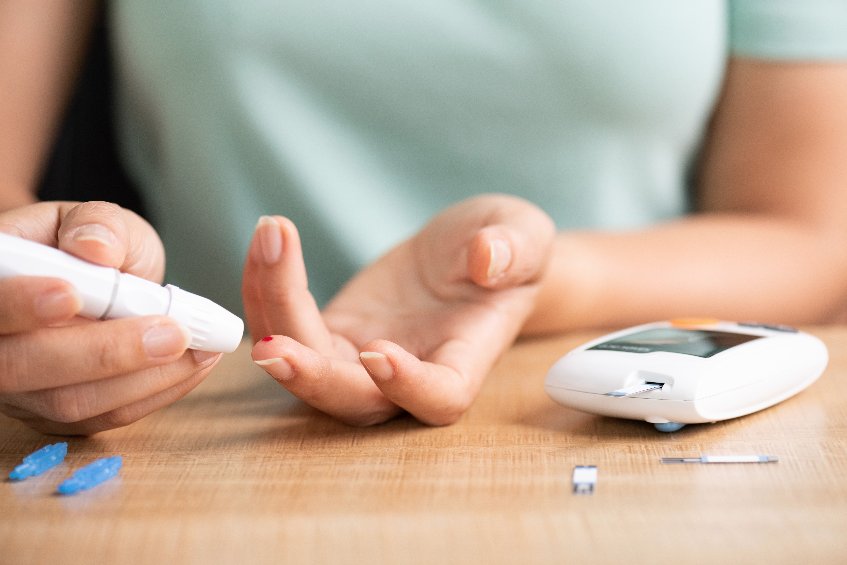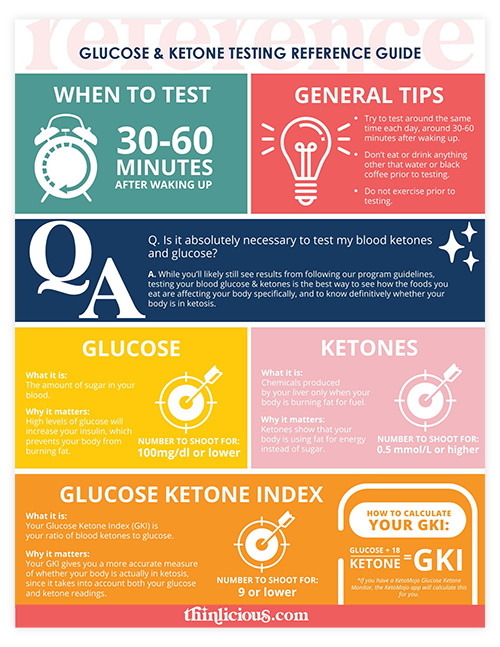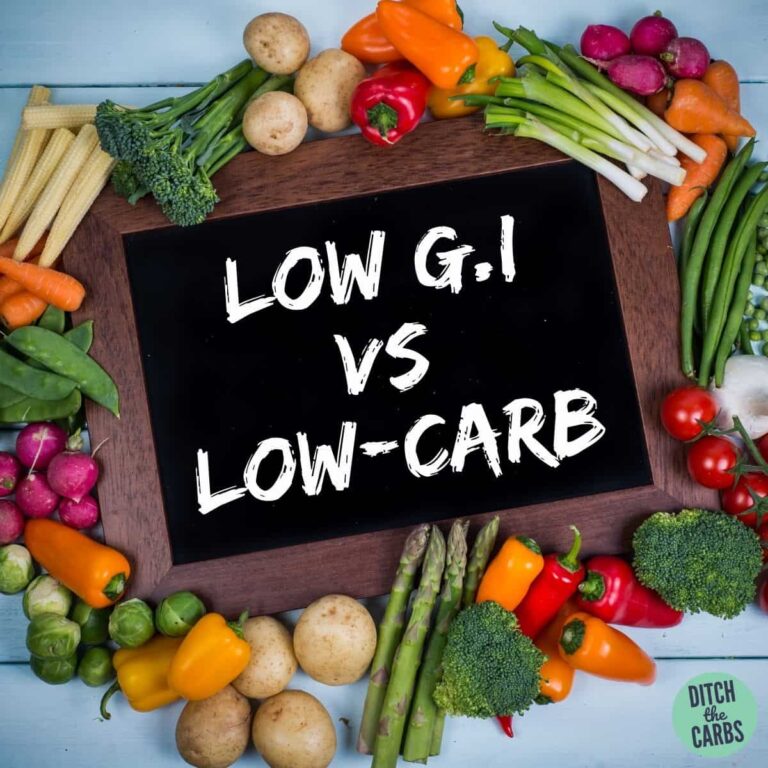Why do you need to do glucose and ketone testing when switching to a low carb or ketogenic diet? How often should you test your blood glucose and ketones? What results should you even be looking for? Is it still possible to see results and reap the benefits of a low carb or ketogenic diet without testing? And is it really necessary to do blood tests?
These are all questions we see often from members of our Thinlicious™ Community when they are first getting started with the 28 Day Metabolism Reset and the Thinlicious way of eating.
And the first thing we want to tell you is that it’s completely normal when starting something new to have a lot of questions and even be a little overwhelmed. So if you’re feeling that way right now, start by just taking a deep breath post and reminding yourself that it’s all going to be okay.
Then grab yourself a cup of coffee and get ready to dig in, because this post is going to lay it all out for you.

Why do you need to test your blood glucose and ketones?
First, you may be wondering “is it really necessary to test my blood? Do I really have to do this—actually prick my finger—in order to see results?” Is glucose and ketone testing really that important?
Are you ready to lose weight and heal your body for life (without dieting, drugs, or making yourself miserable)?

Our free on-demand video training will walk you through how to make this THE year you set health goals…and keep them.
Maybe the thought of it makes you squeamish, or you really just don’t like blood, or you’re not quite ready to make the investment in a blood testing meter.
And we totally get it.
The good news is that you can still see significant benefits & results from following our 28 Day Metabolism Reset plan, or even from just adopting a low carb lifestyle without testing your blood.
You are an adult, which means you ultimately have to make your own choices. No one can make you do anything.
That said, we do strongly recommend testing your blood glucose and ketones regularly, especially when you are getting started with a low carb or ketogenic diet, for a couple different reasons.
First, there’s no better way to understand exactly what’s happening with your body—whether you have actually achieved ketosis and how different foods are affecting you—than to actually measure your blood glucose and ketones. Without actual measurements and hard and fast data, you’ll only ever be guessing, which means you won’t have the same level of confidence.
The ultimate goal of our program is to help women better understand how foods affect their metabolism in an effort to help them prevent common mistakes that sabotage weight loss success. Testing helps encourage success by allowing you to be in tune with your body and how it responds to certain foods.
Second, testing your blood glucose and ketones in order to determine your GKI will give you another way of measuring your progress, other than just the number on the scale. This can be encouraging when it feels like your progress isn’t as fast as you’d like it to be, because it allows you to see that there are other factors at play.
What is glucose and why does it matter?
Simply put, glucose—which is found in carbohydrates—increases your blood sugar levels, which in turn elevates your insulin. When your insulin is high, your body can’t burn fat. And while to a certain extent, everyone’s insulin increases temporarily after eating, the main problem comes from consuming too much glucose on an ongoing basis.
For some people, this leads to insulin resistance, which means your body basically has to begin producing even MORE insulin to be able to process the same amount glucose, which keeps your insulin levels elevated all the time, rather than just after meals. The modern western diet is packed with tons of high-glycemic foods and refined carbohydrates that tend to spike our blood sugar and keep our insulin levels elevated all the time.
And so, instead of having a body that is metabolically flexible and able to switch back and forth from burning glucose to burning fat, your body stays in this self-perpetuating doom loop of consuming glucose, then producing excess insulin to be able to process it.
And while not EVERYONE suffers from insulin resistance, which is why some people can seemingly eat whatever and not have a problem, the sad truth is that insulin resistance is becoming more and more prevalent in our society, mostly due to the steady diet of processed foods and carbohydrates that we all consume. It is estimated that as many as half of adults in the United States have some form of insulin resistance, and according to Dr. Benjamin Bikman, in his book Why We Get Sick, that number could be as high as 88%.
This is a serious problem, because when your body becomes insulin resistant, it’s not just making it harder for you to lose weight, but it’s also increasing your risk of developing type II diabetes, heart disease, and even cancer.
By understanding what foods are causing this spike in your blood sugar, you will be able to confidently make better choice for your body and your health and ultimately reach your goal.
What are ketones, and how do they relate to ketosis?
Ketones are chemicals produced by your liver only when your body is burning fat for fuel. So measuring your blood for ketones is an indicator that your body is using fat for fuel instead of sugar.
Ketosis is a metabolic state that occurs when your body begins to burn fat for energy instead of glucose. Glucose is a sugar that is found in carbohydrates, and tends to be the default source of fuel for your body. When you eat a meal that contains carbohydrates, your body breaks down the carbs into glucose and uses it for energy.
And because carbohydrates are less work & easier for your body to burn, your body will always default to burning carbs FIRST, before burning fat. Thus, as long as you continue refueling your body with carbohydrates, your body will continue relying on carbohydrates as its primary energy source.
Ketosis happens when your body runs out of carbohydrates to burn, and instead begins burning fat for energy. This can happen after a prolonged period of fasting (such as overnight), but it will also happen when you eliminate carbohydrates from your diet. Essentially you are forcing your body to burn fat instead of carbohydrates.
When your body burns fat for energy, it produces ketones. Ketones are a byproduct of fat metabolism, and their presence indicates that your body is burning fat for energy, rather than glucose. While many people assume that ketones are an alternative source of fuel, they’re actually just a byproduct of fat metabolism—a sign that your body is in ketosis.
Explained another way, imagine your body is like a fancy car that can run on two different types of fuel. Fat is like premium gasoline—it’s a high-octane fuel that will keep you running longer and give you lots of energy, but it’s also a little more expensive. Glucose is like regular gasoline—it’s not nearly as powerful or as good for your body as your premium fuel, but it’s much cheaper & easier to burn, so your body’s engine is set to burn the glucose first, as it’s default fuel source.
In a state of ketosis, your body has switched from burning the cheap glucose fuel to running on the premium fuel that comes from fat. And the ketones are like special color exhaust that show up as a result of burning this higher quality fuel. The ketones are the effect of ketosis, not the cause.
What is your Glucose Ketone Index (GKI)?
Your glucose ketone index, or GKI, is your ratio of blood ketones to glucose. Your GKI gives you a more accurate measure of whether your body is actually in ketosis since it takes into account both glucose and ketone readings.
While some devices, such as the Keto Mojo, will calculate this measurement for you in its included smartphone app, you can also calculate your GKI yourself using the following formula:
(Glucose(mg/dL) ÷ 18) ÷ Ketone(mmoL/L) = Glucose Ketone Index (GKI)
How do you test your blood glucose & ketones?
So now that you understand the WHY and the WHAT, let’s take you through the HOW.
To accurately test your blood glucose and ketones, you will need a combination glucose ketone monitor. Here in the United States, these are very easy to find and relatively inexpensive, and do not require a prescription. That said, regulations and availability may vary by country.
We recommend the Keto Mojo device, which you can order online HERE. This is a small device that you prick your finger with in order to get a drop of blood, which you then put on two different test strips that each go into the meter.We have found this particular device to be the most user-friendly, and we also like that it will calculate your GKI.
At a minimum, you will want to test your blood each morning of the 28 Day Metabolism Reset, about 30-60 minutes after you wake up in the morning, but before consuming any food or drink other than water or black coffee.
It is also a good idea to test your blood BEFORE exercise, as working out can cause your glucose to spike temporarily.
What are you looking for when you test?
When you first start testing your blood glucose and ketone levels, you will initially be looking to establish a baseline or starting point. Where you start will depend largely on your current diet and level of insulin resistance. The more refined carbohydrates and processed foods you consume, as well as the higher your level of insulin resistance, the higher your GKI score will typically be.
Your goal is ultimately to bring your GKI down to a level of nutritional ketosis, which is indicated by a score of 9 or lower.
This will typically only happen once your fasting glucose reading is 100mg/dl or lower, and your ketones are .5 mmol/L or higher.
As long as your GKI is 9 or lower, you can consider yourself “in ketosis.” Please note that while your GKI score could get as low as 1, this does not mean a lower score is better, or that your body is burning more fat. This is actually NOT the case. Again, as long as your GKI is under 9, you’re doing great!

If you need help remembering these numbers or the GKI formula, be sure to download and print our free GKI cheat sheet.

Recording & Improving Your Numbers
The best way to improve your GKI numbers and keep your body in a state of ketosis is to start a log where you are not only recording your readings each day, but also what you are eating each day.
This way when you see any impact to your glucose, you have record of what you consumed the previous day and can begin to learn how your body is responding to certain foods and can determine which are good for you and which should be avoided or consumed only in moderation.
We recommend starting with our Thinlicious 28-Day Metabolism Reset, which is designed to introduce you to the Thin-Adapted System and help you retrain the way your body burns fuel in just four weeks. Get it HERE.
PIN FOR LATER

What if you could actually take control of
your health in just 10 days?
It’s not your fault you can’t lose weight as a woman over 40 even though you’ve likely tried literally everything. Your metabolism probably feels broken and your hormones are likely all out of whack.
But you can fix it all with ONE simple change: eliminate sugar. We make it super easy with daily lessons teaching you the science behind what makes us gain weight in our midlife and beyond! Are you ready to get started now?












One Comment